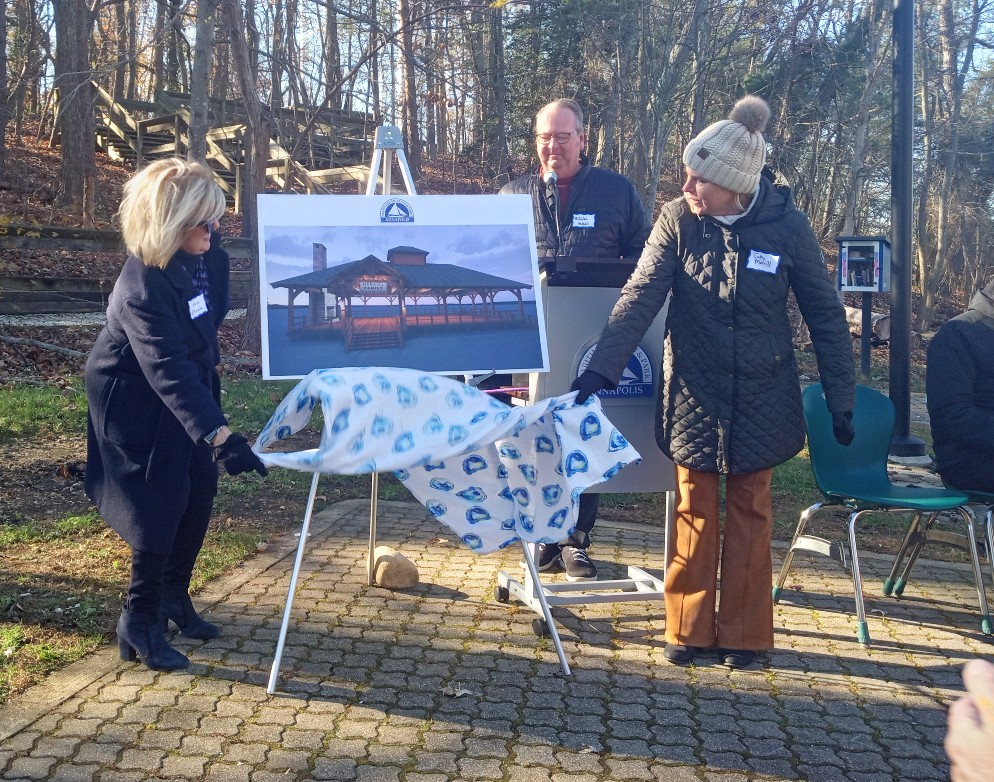Museum Breaks Ground for New Pavilion

By Matthew Liptak
Like the weather on the Bay, water access in Annapolis continues to shift and intensify, but those involved with the Annapolis Maritime Museum see fair weather on the horizon.
The Annapolis Maritime Museum broke ground last week for a new 2,600-square-foot pavilion. The Merrill Family Pavilion will be used for education and event programming at the museum and is expected to be finished in April 2023.
“Having this huge outdoor covered space will allow us to be outside more often, even in foul weather,” said the museum’s education director, Megan Fink. “We can be outside in rain, in a storm, and still be protected and learning about the outdoors and our environment and our rich maritime heritage. I’m pumped.”
The pavilion, located adjacent to AMM’s existing Education Center building on Edgewood Road, will be used primarily as a covered outdoor classroom for overnights, family programs, and school field experiences. The Education Center provides outdoor learning experiences and serves more than 12,000 students annually, with approximately 45 percent of those participants from low-income or underserved communities. This portion of the museum’s campus, also known as the Ellen O. Moyer Nature Park is leased to the organization by the city of Annapolis.
In addition to serving as an outdoor classroom, the pavilion means the museum can extend its meeting/event season into the fall and early spring. Pavilion rentals and ticketed events will generate revenue to support museum programs. The pavilion will feature a custom stone fireplace and distinctive cupola, providing what designers are calling “a natural, ambient, and entirely unique design that creates a sense of place and community connection at the water’s edge”.
The museum will also construct a 400-foot raised boardwalk on Back Creek to allow public access from the shoreline to a new public deep-water dock. The 250-foot-long dock will be a hybrid structure with both fixed and floating components. It will be used as a transient dock with power and water and will serve as a protective berth for the museum’s historic skipjack, Wilma Lee.
“This ADA-compliant boardwalk will allow our students and general public to enjoy the water’s edge without damaging the ecosystem,” said Alice Estrada, executive director of the museum. She added that protecting the Wilma Lee is an added benefit of the expansion. “She’s exposed to some northeasterly winds where she currently resides,” she said. “We will also have some opportunities for the kids to do seining and work on oyster cages.”
Funding for the boardwalk and dock is from Maryland DNR and National Park Service Chesapeake Office.
Wendy O’Sullivan, superintendent of the NPS Chesapeake Office, estimated the cost to be around $85,000. “We know pavilions,” she said. “Pavilions are gathering places. They are memory makers. They will create connections for the public, for kids. That is just something that you just can’t replicate in other ways. We are so excited to see this project moving forward.”
The pavilion is named for the Merrill family. “The Merrill Foundation enthusiastically supports this pavilion project as it creates a space for people to learn about and celebrate their local environment as well as serves as an outdoor classroom,” said Nancy Merrill, president of The Merrill Foundation
“My sister and I and our brother grew up on the Chesapeake,” said Cathy Merrill. “There’s pictures of us in diapers sailing. We love the Chesapeake. We love the opportunity to provide educational opportunities for children, and to learn about the great heritage.”

While supporters of the museum’s projects are enthusiastic about advancing its mission of maritime education, the museum’s plans for the park meant terminating the sublease of Capital SUP, a popular paddleboard business. According to Annapolis Mayor Gavin Buckley, the city is working to help the business find a new location on the water. “We definitely love what they bring to the city and so we’re working with them now on Spa Creek,” he said. “We’ve got some hope for a new location. I loved them when they were on Back Creek, too. We’re looking around in Truxton Park, I’m very excited.”
Currently, Capital SUP still has a location at Quiet Waters Park in Annapolis.
One challenge facing the museum’s outdoor opportunities at their property on Edgewater Road is that increased traffic and availability of parking may bring potential issues. Just across the road, the new Elktonia Beach has opened. Estrada said the museum’s partners are considering different options for handling the potential increase in visitation, which might include shuttles for larger events or perhaps water taxis.
“We know that we have very limited parking here,” she said. “We basically have 35 spaces. It’s something we’re hoping we can tackle together.”
In 2007, Annapolis Maritime Museum educated 300 children through its programs. In 2022, Estrada said, that number has grown to almost 12,000 children annually–45 percent of them being from underserved populations.
